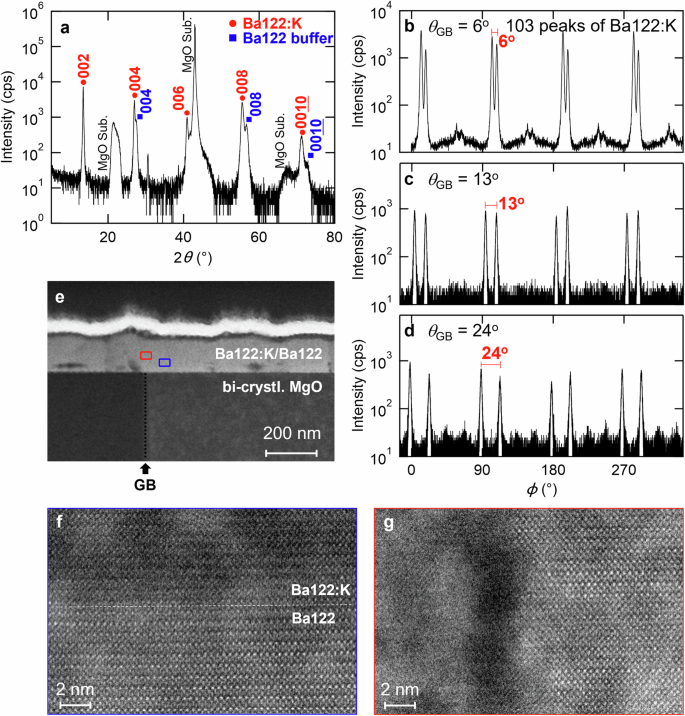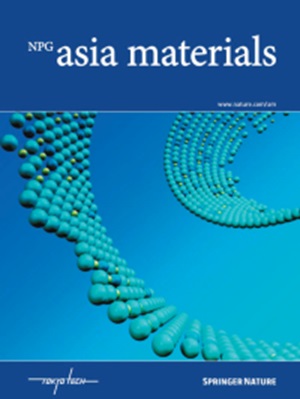High tolerance of the superconducting current to large grain boundary angles in potassium-doped BaFe2As2
IF 8.3
2区 材料科学
Q1 MATERIALS SCIENCE, MULTIDISCIPLINARY
引用次数: 0
Abstract
Superconducting magnets based on high-temperature superconductors (HTSs) have become critical components in cutting-edge technologies such as advanced medical applications. In HTSs, weak links of superconductivity are inevitable at high-angle grain boundaries (GBs). Thus, two adjacent grains should be crystallographically aligned within the critical angle (θc), for which the intergrain critical current density (Jc) starts to decrease exponentially. The θc of several iron-based superconductors (IBSs) is larger than that of cuprates. However, the decreases in both θc and intergrain Jc under magnetic fields for IBSs are still substantial, hampering their applications in polycrystalline forms. Here, we report that potassium-doped BaFe2As2 (Ba122:K) exhibits superior GB performance to that of previously reported IBSs. A transport Jc of over 0.1 MA/cm2 across [001]-tilt GBs with misorientation angles up to θGB = 24° was recorded even at 28 K, which is a required level for practical applications. Additionally, even in an applied magnetic field, θc was unaltered, and the decay of the intergrain Jc was small. Our results highlight the exceptional potential of Ba122:K for polycrystalline applications and pave the way for next-generation superconducting magnets. We have fabricated artificial grain boundaries in K-doped BaFe2As2 (Ba122:K), one of the Fe-based superconductors. The crystalline orientation map, acquired through the scanning precession electron diffraction measurements, revealed that spontaneous connectivity modification occurred at the grain boundary, which may mitigate weak-link behavior. Specifically, a self-field critical current density Jc of over 0.1 MA/cm2 across the grain boundary with misorientation angles up to 24° was recorded even at 28 K. This performance surpasses the grain boundary properties of hitherto reported Fe-based superconductors. Our results highlight the exceptional potential of Ba122:K for polycrystalline applications and pave the way for next-generation superconducting magnets.


掺钾 BaFe2As2 中超导电流对大晶界角的高耐受性
基于高温超导体(HTS)的超导磁体已成为先进医疗应用等尖端技术的关键部件。在高温超导体中,高角度晶界(GB)处不可避免地会出现超导薄弱环节。因此,两个相邻晶粒应在临界角 (θc)范围内结晶排列,此时晶粒间临界电流密度 (Jc) 开始呈指数下降。几种铁基超导体(IBSs)的θc都比铜氧化物大。然而,在磁场作用下,铁基超导体的θc 和晶粒间 Jc 的下降幅度仍然很大,这阻碍了它们在多晶体形式中的应用。在这里,我们报告了掺钾的 BaFe2As2(Ba122:K)与之前报告的 IBS 相比,具有更优越的 GB 性能。即使在 28 K(这是实际应用所需的水平)的条件下,我们也能记录到跨越[001]倾斜 GB 的传输 Jc 超过 0.1 MA/cm2,其错位角可达 θGB = 24°。此外,即使在外加磁场中,θc 也不会发生变化,晶粒间 Jc 的衰减也很小。我们的研究结果凸显了 Ba122:K 在多晶应用领域的巨大潜力,并为下一代超导磁体的发展铺平了道路。
本文章由计算机程序翻译,如有差异,请以英文原文为准。
求助全文
约1分钟内获得全文
求助全文
来源期刊

Npg Asia Materials
MATERIALS SCIENCE, MULTIDISCIPLINARY-
CiteScore
15.40
自引率
1.00%
发文量
87
审稿时长
2 months
期刊介绍:
NPG Asia Materials is an open access, international journal that publishes peer-reviewed review and primary research articles in the field of materials sciences. The journal has a global outlook and reach, with a base in the Asia-Pacific region to reflect the significant and growing output of materials research from this area. The target audience for NPG Asia Materials is scientists and researchers involved in materials research, covering a wide range of disciplines including physical and chemical sciences, biotechnology, and nanotechnology. The journal particularly welcomes high-quality articles from rapidly advancing areas that bridge the gap between materials science and engineering, as well as the classical disciplines of physics, chemistry, and biology. NPG Asia Materials is abstracted/indexed in Journal Citation Reports/Science Edition Web of Knowledge, Google Scholar, Chemical Abstract Services, Scopus, Ulrichsweb (ProQuest), and Scirus.
 求助内容:
求助内容: 应助结果提醒方式:
应助结果提醒方式:


